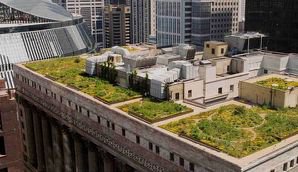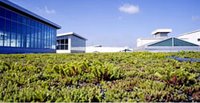One component of this that I'm a big fan of has been the movement to incorporate green roofs into especially city dwellings. This can mean anything from not using the typical black tar roofs (which hold in heat, contributing to the urban heat island effect) to creating almost a garden on the roof. This can be done on anything from a small home to skyscrapers.

An example of this is the City Hall rooftop in Chicago. Chicago has become known as a center for green technology and roofs are no exception. For instance, a $5,000 grant from the city is available for anyone who wants to create a green roof.
Lately, the push for usage of this option nationally has grown stronger. A blog called WorldChanging has a pretty extensive rundown here. They say:
Green roofs add so many benefits to a building and its surrounding area, it's astonishing that more roofs aren't green at this point... Although green roofs cost more up front to install than regular roofs, the savings that they accrue over the years quickly pay off.There are of course future maintenance concerns and concerns about the roof's durability, but to me, the idea of making green roofs more commonplace is a no-brainer. I have to think that the opportunity to lounge on a garden in the sky would be pretty attractive to most people.

For further information or if you're interested in becoming an advocate in your city, you could consider joining the "Green Roofs for Healthy Cities" campaign.
I have the feeling that this is an idea that will only continue to grow.

1 comment:
This reminds me, in an odd way, of my first visit to the new $60 million computer science building (Siebel Center) at UI-Chambana this past spring. When I toured the facility, I ended up being disappointed. At first, I figured it was because my hopes had been too high. However, as I thought about it more while still in the building, I realized that I just found the place to be, in general, depressing.
As I walked up the steps from the 2nd to 3rd floor, I couldn't help but feel as though I were inside a robotic arm. The building's structure around me at that moment would have been totally cool to see in a movie, but not at all cool for actually living, working, or learning on a daily basis (in my opinion... I realize others will disagree).
Don't get me wrong, the building is very impressive on multiple levels -- including architectural, functional, and technological; and I might have a happier impression of it if I were to tour it under different circumstances (I toured it alone on a slow Saturday with overcast sky.) Although, honestly, I don't think my impression would change 180 degrees. As I was ready to exit the building, I started surveying it one "final" time, picturing it in a more "natural" state. Could they have used more (any) wood? What about a waterfall? It just seemed that, aside from all the windows, they made no attempt at having the building's interior mimic nature and thus missed an opportunity to see what could be accomplished in this area.
Also adding to my disappointment was the fact that the large building is crammed into a relatively small block of area. Just outside the building was a grassy area, but it was on a steep hill and the grass was dead. Of course, this was in March, but still, I imagine it's difficult to keep that grass healthy. They'd probably have better luck growing the grass on the roof...
(NOTE: I'm still jealous of the students who get to use this facility. It's way better than DCL!)
Post a Comment